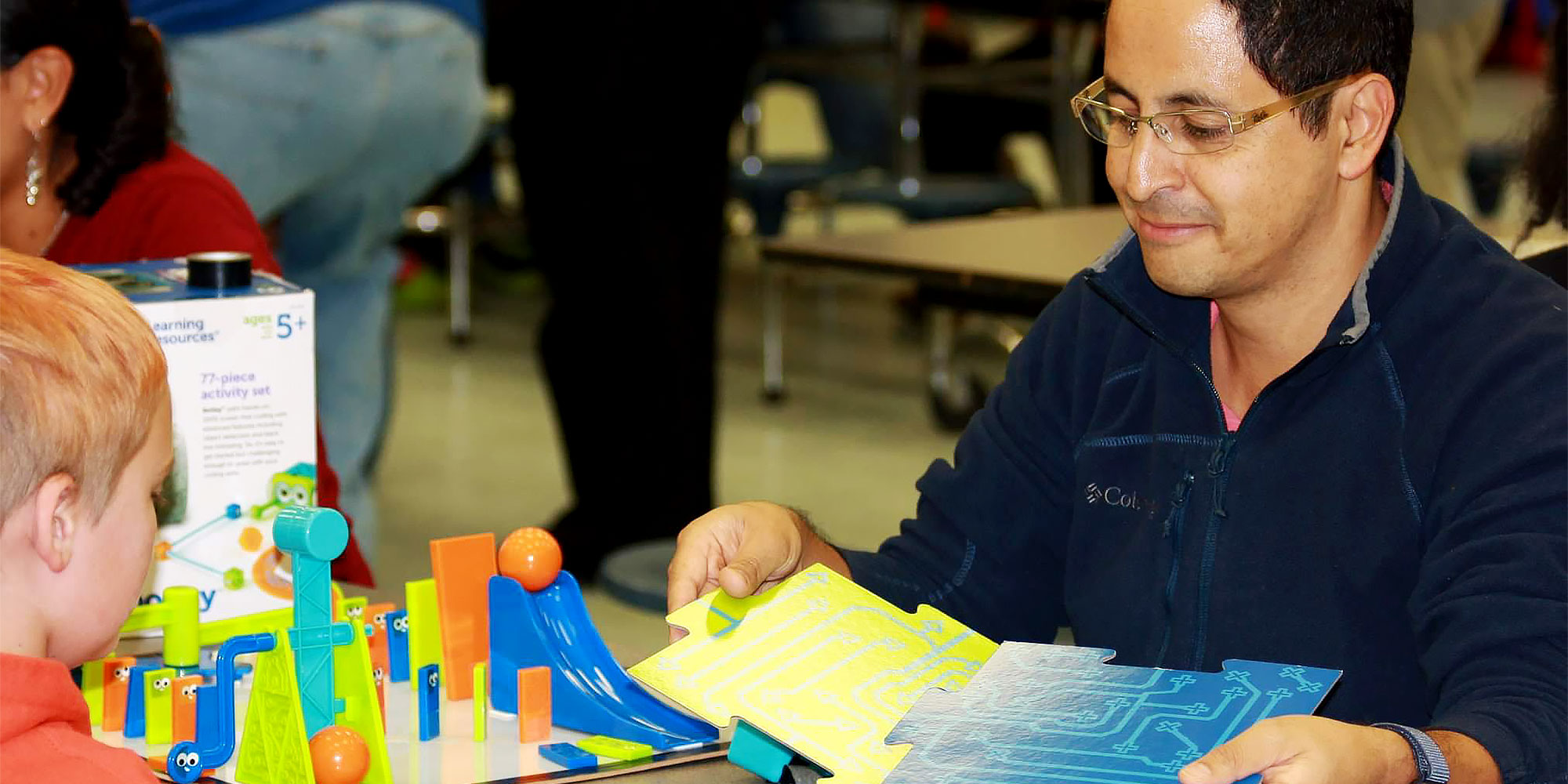When John Mendoza-Garcia, now Ph.D., was studying for his doctoral degree in engineering education, he quickly learned why many students avoid going into the engineering field.
“They do not know what engineers do and ignore their social impact,” said Mendoza, now a graduate coordinator and associate engineering professor with UF’s Department of Engineering Education.
Thus, in 2019, he established STEAM night at C.W. Norton Elementary School in northwest Gainesville. STEAM stands for Science, Technology, Engineering, Arts and Math. Art is an important part of the program, he contends, as skills like creative thinking, critical thinking and design are crucial in problem-solving.
The program has grown in scope, size and curriculum. Last school year, the program averaged 150 students. With participation from parents, total attendance often runs between 300 and 400.
The program is such a success that the school granted Mendoza-Garcia a Volunteer of the Year Award in April.
“I truly believe our STEAM Night has grown, improved and flourished thanks to Dr. Mendoza-Garcia’s leadership. His ongoing commitment has built strong relationships with our presenters— many of whom now look forward to returning each year. Our students love reconnecting with familiar faces while also discovering something new at every event,” said Elena Mayo, then principal at Norton Elementary and now principal at Talbot Elementary School.
Mendoza-Garcia gives much of the credit to Mayo, the PTA, volunteers and Norton teachers. They were the ones who took the idea, made it happen and continued to support it. He also credits his colleagues in EEd for giving him the flexibility to put in the time and energy to make it a success.
All the same, he and his wife, Andrea Bohorquez — an instrumental part of STEAM night — were surprised and humbled by the award.
“We do not do this event hoping to get any recognition but just to contribute to the community the school serves, which includes a high percentage of low-income families,” Mendoza-Garcia said.
The hands-on, annual program for grades kindergarten through fifth runs in late March, stressing that engineering is a profession in which people build and design things that make a difference, solve problems creatively and are essential to health, happiness and safety.

Mendoza-Garcia earned his Ph.D. at Purdue University and his master’s and bachelor’s degrees in systems and computing engineering at the Universidad de Los Andes in Colombia. At UF, he researches the “Ability to Address Complex Socio-Technical Systems,” a construct that utilizes different skills and knowledge engineers need when developing solutions for socio-technical organizations.
Here is more on Mendoza-Garcia and the celebrated STEAM Nights.
Why did you start volunteering at the school?
My daughter was a student at C.W. Norton Elementary School until 2023. Once she completed elementary school, we decided to continue doing the STEAM Night since we believe in its impact on developing crucial skills for success and on contributing to changing the imaginarium about what scientists and practitioners from different STEAM fields do.
However, our daughter’s enrollment at Norton is not the main reason why we volunteer there. Norton Elementary is a Title I school that serves a large percentage of students from low-income families, and we like the idea of helping these kids.
What are the goals of STEAM night?
STEAM night is trying to make STEM fields attractive to students. Who knows? Maybe one or more of them decides to pursue a career in one of these STEM areas in part because of their participation in one or more STEAM nights.
In addition, we believe that role models are crucial when thinking about career paths, and students from this school can get access to UF students who become those role models that inspire the kids to pursue a career in these areas. Similarly, the STEAM Night attracts professors who know how to make their activities easier to understand. Many organizations also bring their technology so kids can learn about them and what they do.
In short, it is knowledge at their fingertips — literally, since these organizations bring hands-on activities.
How are activities selected?
There are activities brought by teachers or some other vendors in which students can plan, design, test and improve — programming a robot to complete a simple task, rescue a piece of candy from the water and making aluminum foil boats float. There are also catapult designs.
How was the program created?
I advocated for it to the PTA and the school principal, building on my experience with a STEM event in which I was invited by one of my co-advisors while completing my Ph.D. in the Department of Engineering Education at Purdue University. When arriving in Gainesville, I built on that experience and presented this idea to the school PTA. In that meeting, I received support from PTA members, teachers and the school’s principal, Elena Mayo.
What do you do when you are not working or volunteering?
We like sharing time together with our daughter. We enjoy stargazing, and we chase astronomy events like a total eclipse of the sun. We like hiking in natural parks, going to theme parks and the beach, watching movies and playing strategy board games.
Tell us about your wife.
Andrea received her bachelor’s degree in electronic engineering from Universidad Javeriana in Bogota, Colombia, and she has a specialization in robotics. She works for a sport fishing company called Anglers Inn International – Suite Life on The Water. She has volunteered several times at the school — proctoring exams, helping in the spring festival, book fair and the STEAM night, among others.
For the STEAM night, Andrea was one of the vendors for the first three years with robotics-related activities. She is also the main photographer.

